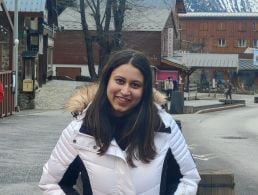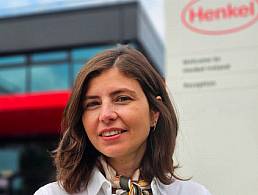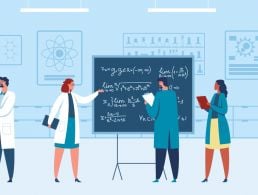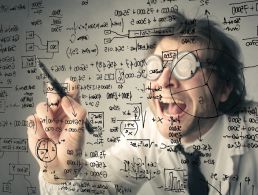Dr Sarah Guerin of SSPC talks about her work modelling and growing pharmaceutical crystals, and why work-life balance is crucial for scientists.
Dr Sarah Guerin is a computational biophysicist at SSPC, the SFI Research Centre for Pharmaceuticals, and the Department of Physics in University of Limerick’s Bernal Institute.
She spoke to us about her love for “using physics to describe how things work in the body” and why it’s important that scientists don’t make research their whole life.
‘It’s all about the transferable skills, then the science just falls into place’
– DR SARAH GUERIN
What is your role within SSPC?
I call myself a computational biophysicist to sound fancy, but really I just study how materials will work in the body, and I get a lot of help from my computer.
What experiences led you to the role you have now?
I got my degree in applied physics in 2015, which got me interested in scientific research, particularly nanotechnology. In my PhD, I worked on a method of studying crystals using computer models. Using quantum mechanics (the dark arts of physics!), I could predict how crystals would behave before I made them in the lab.
For that project, I worked on crystals that generated electricity when you pressed them, which had applications in electronic devices. I built up my skills in biology and chemistry, as well as physics and computer modelling. It made me fall in love with crystal science: studying, modelling, growing and characterising them (taking colourful pictures, mainly).
This set me up perfectly for the role I have now, having gotten my PhD in 2018 in modelling and growing pharmaceutical crystals.
Can you tell us about the research you’re currently working on?
So, a lot of the medicines we take every day, like paracetamol and ibuprofen, are actually made up of very small paracetamol and ibuprofen crystals. The properties of these crystals affect everything, from how much it costs to make the medicine to how fast it gets rid of your headache.
I’m using my computer models to predict these properties, so that in the lab we can focus on growing the best crystals. I can also use this information to design crystals that haven’t been made before, which can lead to new, better and cheaper medicines.
What first stirred your interest in this area?
While my focus has always been physics, the research that I’ve been carrying out in the Bernal Institute for the past five years has combined all of the sciences together in a way that I’ve been enjoying more and more.
My interest in using physics to describe how things work in the body, I suppose, started in my undergrad, when we were learning about the physics of medical devices, which is something I’d like to work on when I have my own lab – fingers crossed – one day.
If there is such a thing, can you describe a typical day for you?
Maybe not a typical day, but my ideal workday would start at home with avocado and eggs and a large mug of tea that I finish on the drive to work. I drive in with my partner Cian, who is also a scientist and teaches physics in the university.
When I arrive in the morning, I will grab a second tea from our building barista Pat and sit down at my desk to check my computer simulations.
We run our simulations on the large Irish supercomputer, whose name is Kay, in Galway, which we can log into from our own computers. Depending on how big the crystals I am interested in are, the simulations can take 20 minutes to a week to finish.
After that I will answer any emails I have. They could be about reports, papers, science-communication projects, meetings with my supervisors or other scientists, or my teaching schedule. I do up to eight hours of teaching a week, which includes chemistry and physics labs, tutorials and lecturing.
Then it’s off to the lab to check on crystals which are growing or to test the properties of crystals that have grown successfully. I also have to characterise my crystals so that I know as much as possible about them. I do this with a variety of microscopes and x-rays.
The day moves quickly from there. I like getting lunch off-campus with my friends, often at the Hook and Ladder in Castletroy. The afternoon could be anything from meetings to more lab work, to reading papers or building models and analysing data. I have collaborators in Singapore, Israel and the US, so sometimes we have to coordinate time zones for Skype calls.
What skills and tools do you use on a daily basis?
It’s all about the transferable skills, then the science just falls into place. Patience, time management and a good filing and note-taking system. I’ve been using the Pomodoro technique while working from home and that has been a lifesaver. Noise-cancelling headphones, a daily walk and breathing exercises.
What applications do you foresee for this research?
I think a really exciting area of pharmaceutical research is combination medicines. We already take multivitamins, which are lots of different vitamins and minerals in one tablet that keep all of their own properties. For example, vitamin C and iron don’t react together to make something new. This is surprisingly difficult to do for other medicines, but we have started to see it recently, for example with tablets that contain both paracetamol and ibuprofen.
The computer models that we use could be really useful in the future to predict what drug molecules can exist together in a tablet, potentially leading to personalised medicines. Imagine people who take six tablets a day only having to take one that treats all of their conditions.
Are there any common misconceptions about this area of research?
I think it’s a common belief that the pharmaceutical industry is this scary money-making machine. People are always shocked when I say I’m working with industry to make cheaper drugs.
SSPC has a brilliant outreach programme where we engage with many people across the country from ages eight months to 108 years to teach them about what we do and why, and about crystal science. This helps to answer a lot of questions about our research.
When you first started work as a researcher, what were you most surprised to learn was important in the role?
A solid support network. Having people who will meet you for coffee or grab a pint on the weekend is essential. It’s really easy as a scientist to make your research your life. An active social life, hobbies and exercise have become essential for me, especially for my mental health. It makes you a more balanced person and a better scientist.
What do you enjoy most about your career in research?
I’m in an extremely lucky position where I can see an idea through from thinking of it to model-building on my computer, to verifying the model in the lab and then realising an application – when it works!
It’s an amazing feeling to see a prediction become reality, and my hope is that I will continue to combine modelling and experimental work throughout my scientific career.




